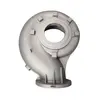Mobile:+86-311-808-126-83
Email:info@ydcastings.com
Understanding the Wax Casting Process for Precision Metal Fabrication Techniques
The wax casting process, often referred to as investment casting, is a highly versatile and precise metal forming technique widely used in various industries, including aerospace, automotive, and art. This method is particularly valued for its ability to produce intricate shapes with excellent surface finishes and tight tolerances, making it an ideal choice for components that demand high accuracy and detail.
The process begins with the creation of a wax pattern, which is a replica of the final product. This pattern is typically made from a high-quality wax that can be melted away easily in later stages. The patterns are usually produced through injection molding, which allows for the efficient creation of complex shapes. Once the wax patterns are prepared, they are assembled into a tree-like structure to maximize production efficiency.
The wax casting process, often referred to as investment casting, is a highly versatile and precise metal forming technique widely used in various industries, including aerospace, automotive, and art
. This method is particularly valued for its ability to produce intricate shapes with excellent surface finishes and tight tolerances, making it an ideal choice for components that demand high accuracy and detail.Once the ceramic shell has fully dried, it is subjected to heat to remove the wax. This process, known as dewaxing, involves placing the shell in an autoclave or oven where the wax melts away, leaving behind a hollow ceramic mold that retains the shape of the original pattern. This step is critical, as any remaining wax can affect the quality of the final casting.
wax casting process

With the wax removed, the ceramic mold is then preheated, usually to a temperature of around 400-600°F (200-315°C) to prepare it for the molten metal. Various metals, including aluminum, steel, and titanium, can be used depending on the required properties of the final product. The molten metal is poured into the mold, filling the cavity left by the wax pattern.
After the metal has cooled and solidified, the ceramic shell is broken away, revealing the cast component. This part may then undergo further processing, such as machining, polishing, or heat treatment, to achieve the desired finish and mechanical properties.
In conclusion, the wax casting process is a remarkable manufacturing technique that provides high-quality and detailed metal components. Its ability to accurately create complex designs, coupled with the versatility of materials used, makes it an essential process in modern engineering and manufacturing. As technology advances, the applications and efficiency of wax casting continue to expand, solidifying its place in various industrial sectors.











